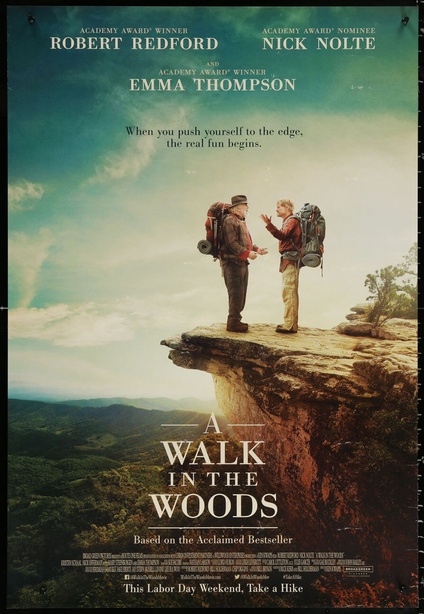Directed by: Ken Kwapis

Bill Bryson’s report of his attempt to hike the Appalachian Trail, entitled A Walk in the Woods, is a funny, intelligent, self-deprecating narrative. This movie, built on the book, is not.
Directed by Ken Kwapis, who has spent much of his career directing episodes of television sitcoms, the movie relates the story of Bryson, recently returned home from England and wanting to “experience America” once again, deciding that one way he could do that would be to get out into the most famous place in the wilds of the Eastern U.S. and walk. The AT provides the beauty and the challenge of hiking the spine of the Appalachian Mountain range from Springer Mountain in North Georgia to Mount Katahdin in the wilderness of Maine. The trail is rigorous and glorious, but barely a fifth of those who start out in the spring in Georgia make it to the peak of Katahdin. Bryson, and his hiking buddy, Stephen Katz of Iowa, were not among them.
The book is filled with fascinating detail of important points along the way from Civil War history to ancient geology, but its attraction centers in Bryson’s ability to describe the people and circumstances he encounters, which form the real heart of America for him. From Katz himself, woefully out of shape and unprepared for the strenuous ordeal he was attempting, when he meets Bryson to begin, and the gradual growth of Bryson’s appreciation for his friend and his perseverance to his descriptions of the people he and Katz meet as they hike, both Bryson’s humor and his wonder at the beauty of the trail never fail him.
The movie, though it contains both these elements, lacks the elegance and the depth of Bryson’s telling of them. Robert Redford plays Bryson, and Nick Nolte plays Katz. Neither actor is up to the task. Redford simply displays no gift for the easy-going, acceptance Bryson has for both the rain, mosquitoes, arrogant young through-hikers and the like, and the awe-inspiring panoramas, gentle kindnesses, and historical insights, which form the focus of his story. Redford is too reflective and intellectual in his approach to the role. Nolte, on the other hand, seemed to chafe against being second fiddle and tries to make Katz more important and wise than he should, and certainly than the character in the book. If Redford had been more assertive as the leader and joke maker Bryson is, and Nolte had been more willing to be his foil, the movie would have been lively. As it is, it sits there like a lump, and the viewer leaves asking, “OK, why did I go see this again?”
Both these actors are too good at their profession to sink the movie, though; the fault for that lies at the feet of Kwapis. Walk is a strongly character-driven movie, but it fails almost entirely to capture the most important character of all—the woods. There are beautiful shots of early morning campsites, of ridges of green that is so deep and quiet, they are almost blue (hence the name “Blue Ridge Mountains”), which Bryson and Katz also spend some time in. But shot with far too many tightly-framed scenes of people sitting around picnic tables talking or cooking around campfires, the beauty of the majestic Shenandoah Valley or the grandeur of the Smoky Mountains, as well as the comfort of the streams and waterfalls, the dew saturated trees, the rocks and ferns and flowers, all this takes far too much of a back seat.
Perhaps the tone of Bill Bryson’s book is just not accessible to film as a medium, but movies—A River Runs Through It or Dances With Wolves just scratch the surface—have regularly shown that nature can play a deeply important role in a film. A Walk in the Woods fails to give it that role.
For Christians, the movie has very little religious discussion. Neither of the principals appears to be people of faith, and I at least don’t recollect any particular scenes of interest in questions that flow from believing in God. Perhaps if I saw it again, I would go, “Of course, how could I forget that?”, but as of this writing, one simply sees two men, who are loose friends from long ago, going out into nature with a goal in mind, and becoming deeper friends by the end of their quest. Not a bad way to spend two hours, even if the medium for such thoughts is not as good as it could have been.
Drew Trotter
October 7, 2015